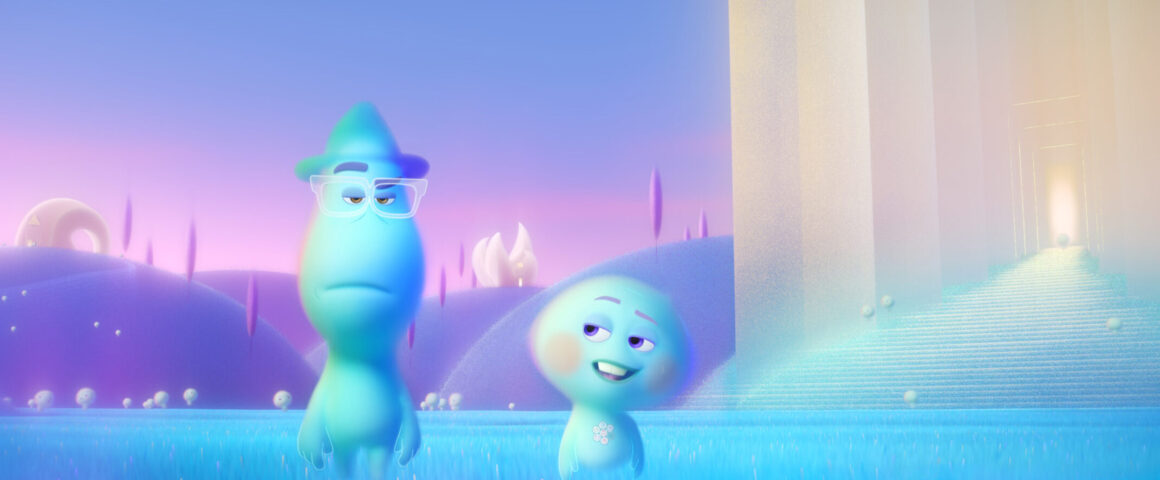Why am I here? What is the meaning of my existence? What happens when I die? What is the mind? What is my personality? Why am I? Deep and profound questions, well suited to a long cinematic chin-stroker such as Andrei Tarkovsky’s “Solaris” and Terrence Malick’s “The Tree of Life.” Or a swift, snappy animated comedy adventure about a jazz musician. Wait, what?
Sure enough, Pixar have done it again. In Pete Docter’s Soul, these weighty questions are explored in a dazzling and sublime ride of visual imagination. Jazz musician and teacher Joe Gardner (voiced by Jamie Foxx, “Baby Driver”) finds himself heading for the Great Beyond, his soul confronting the end of his life just as he found what he believes to be the reason for it. Rather than face the Great Beyond, Joe flees into the Great Before, a training ground where souls develop personalities before they join bodies. In a desperate attempt to get back to his body on Earth, Joe attempts to mentor Soul 22 (voiced by Tina Fey, “Muppets Most Wanted”), a soul with no spark who cares about nothing. Cue hilarity, bonding and (literally) life lessons.
Anyone with a fondness for creativity such as art, performance or, of course, music, will find Joe relatable, chasing after his big chance for years before finally getting it, only to lose out on this chance due to unexpected events. Notably, there are sequences in the film that express a transcendent experience, in Joe’s case related to music. Crucially, however, an understanding of, or passion for, music is not essential, as the feeling being expressed is intangible and universal while also being unique. This is a remarkable balance to strike, and Docter along with co-director Kemp Powers do so by trusting in the image. Soul provides dialogue exposition for the soul dimensions, often delivered to a comically uncomprehending Joe, but sweeping pan shots, shifts in lighting and the fluid motion of Joe’s fingers on the piano create the sense of an elevated experience. This is cinema in its highest form, demonstrating the limitless potential of animation especially, as Soul emphasizes that an experience, of many varieties, can take someone to another place. Along the way, the film shows a variety of such experiences, as well as the reverse in the form of lost souls, featuring in sequences that are as moving as the death of Bambi’s mother or Mufasa in “The Lion King.” Throughout, the creativity of the animation is spellbinding, making the otherworldly places as well as the souls themselves completely believable and engaging.
For Pixar to deal with such subject matter is not without precedent. “WALL-E” used robots and programming to pose questions over the meaning of existence; “Toy Story 3” confronted mortality and obsolescence; “Inside Out” told audiences of all ages that it is OK to be sad and that growth and change are healthy. Soul is, therefore, a continuation of the studio’s experiments with the medium of animation. The Great Before is rendered (and explained to be rendered) in such a way as to be comprehensible to Joe’s mind, and therefore the viewer’s (and of course the creators, who are themselves only human). This makes the spiritual realm charming and funny but also wondrous. The various counselors, all called Jerry because reasons, appear out of the surrounding space, overtly other and yet understandable. Docter and Powers, along with their fellow screenwriter Mike Jones, use a tried and tested method of presenting the organization of the spirit world as highly bureaucratic, recalling “Beetlejuice,” “O Heavenly Dog!” and especially “A Matter of Life and Death,” a clear influence on Soul. This bureaucracy is the source of much humor in the film, as records, statistics, training techniques and dealing with difficult colleagues receive ample attention. Furthermore, an unexpected development in the second act leads to some fantastic physical comedy that echoes “All of Me” among others. Many lessons are learned, some involving further colorful characters including Moonwind (voiced by Graham Norton, “I Could Never Be Your Woman”) and Curley (voiced by Questlove, “Beats Rhymes & Life: The Travels of a Tribe Called Quest”). Meanwhile, Joe and 22 make for a great comedy double act in the spirit of Woody and Buzz, Mike and Sully, Dory and Marlin, Joy and Sadness. All the voice performances are great, the characters richly nuanced and detailed.
In addition, Soul deserves attention for being the first Pixar film to feature an African-American lead. It is notable that Powers’ involvement increased from consultant to co-writer to Pixar’s first African American co-director, but at no point does the film make an emphatic political point. Rather, it allows the artistry to express the political progression by making Soul partially a film about the black community. This includes the setting, the supporting characters, an insightful scene that takes place in a barber’s, and of course the use of jazz. The film has been criticized for “whitewashing” blackness, as the soul figures are bereft of color. But it is notable that Joe’s appearance is retained in his soul, including his hat and glasses, whereas 22 and the other trainee souls are essentially blank, rather than presenting the color of white people as some kind of default. This design choice reinforces the film’s conceit that personality shapes appearance rather than the other way around, and people need to be seen as people, each with personalities and their own unique spark. In terms of progressive representation, imagine if that was how we saw everyone, as a person, an individual, each capable of our own extraordinary contribution.



